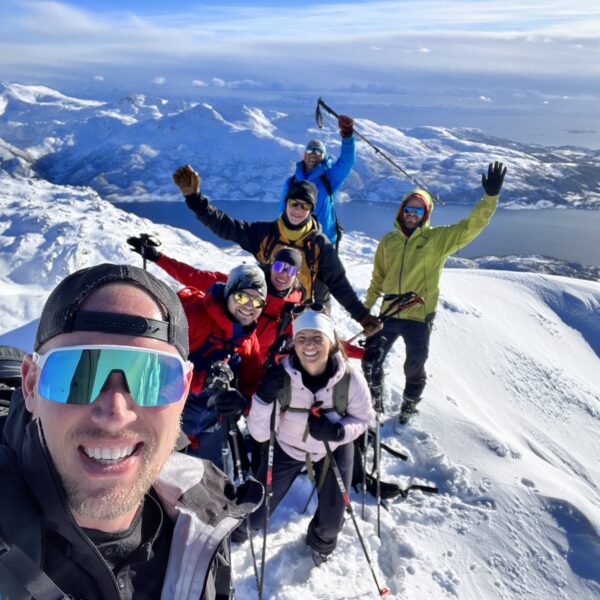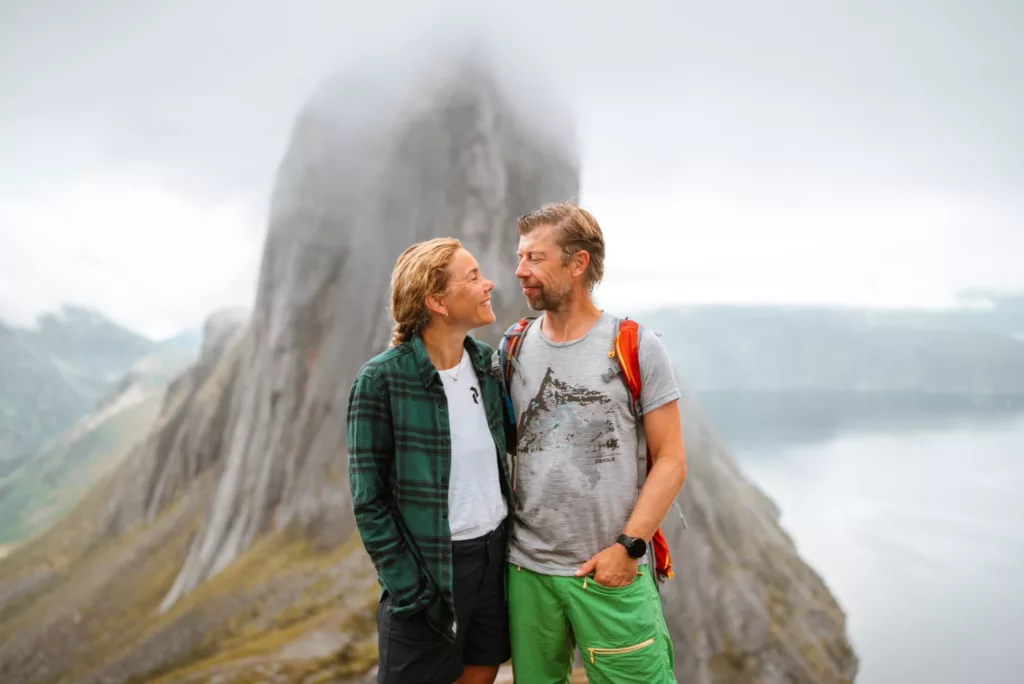
Vesterålen & Senja
Norway’s Quiet Northern Escape
Vesterålen: Wide Horizons, Quiet Shores
While Lofoten often steals the spotlight with its steep peaks and tourist buzz, Vesterålen offers something different. The landscape here is more varied and open. Rolling hills, wide plains, and calm inlets create a softer, slower rhythm. The atmosphere is more laid-back. You’ll find fewer buses, less camera gear — and more space to breathe. Vesterålen is for those who seek the northern light & the midnight sun without the crowds.
One of the most popular places we visit is the legendary Trollfjord. Keep an eye out for trolls — we’ll share the saga when we arrive! In summer, we hike these dramatic surroundings. In winter, we ski them.
Senja: Sharp Peaks, Few Footprints
Senja is Norway’s second-largest island, yet far less known than its neighbor. The mountains here dive straight into the sea. Peaks like Segla, Husfjellet, and Hesten are bold silhouettes against the sky, and from the top, you’ll see ocean on every side. While Lofoten may feel curated, Senja feels untouched — a place where nature leads, and people follow quietly.
Senja is often called a “mini-Lofoten,” but that doesn’t quite capture its personality. It’s not just smaller — it’s wilder. The roads are narrower, the hikes a bit rougher, the silence deeper.
A hidden Alpine Paradis for ski touring
From February to May, Senja transforms into a remote ski touring paradise. Here, you ski from summit to shoreline. The terrain suits both beginners and experienced tourers, and with a sailboat as your basecamp, you wake up each day beneath new peaks. The island’s slopes provide a perfect backdrop for skiing, with popular mountains such as Husfjellet, Keipen, and Kvænan standing out as some of the best spots.
Compared to Lyngen or Lofoten, Senja has fewer marked routes and more space for discovery. For those looking to break away from the ski crowds, it’s a place to carve your own lines.
Freedom Under Sail
With a sailboat, the map opens up. From Senja, it’s a short sail to island gems like Husøya and Dyrøya. These are not places you’ll find in guidebooks. But they’re where the locals fish, where you can drop anchor and go ashore for a midnight swim, or climb to a peak with nobody else around. On board, the rhythm of the wind sets the pace. It’s not about getting somewhere fast — it’s about seeing what’s around the next headland.
Sustainable by Nature
Senja is certified as a sustainable destination — a commitment to protect its landscapes and community from the pressures of overtourism. Arriving by sailboat fits that philosophy. We move slowly, with minimal impact. We support small, local suppliers. We don’t leave much behind — just footprints in the snow and salt in our hair.
Trips in Vesterålen & Senja
-
 Ski & Sail Expedition Festival, Svolvær – TromsøNOK 36.500
Ski & Sail Expedition Festival, Svolvær – TromsøNOK 36.500 -
 Hike & Sail, Tromsø – LofotenNOK 25.500
Hike & Sail, Tromsø – LofotenNOK 25.500 -
 Ski & Sail Easter Expedition from Lofoten to TromsøNOK 39.500
Ski & Sail Easter Expedition from Lofoten to TromsøNOK 39.500
FAQ Senja & Vesterålen
How demanding is skiing in Senja?
The terrain offers something for everyone. Beginners will find forgiving slopes and easy access from the water. Experienced skiers will discover challenging couloirs and summit-to-sea runs.
Why is Senja becoming more known?
Social media has brought attention to iconic peaks like Segla, but most of the island remains quiet. Its combination of rugged nature, low visitor numbers, and raw authenticity is increasingly appealing.
When is the best time to visit?
For ski touring: late February to early May. For sailing, hiking, and exploring by sea: June to August. In winter, the northern lights add an extra dimension from October to February.



